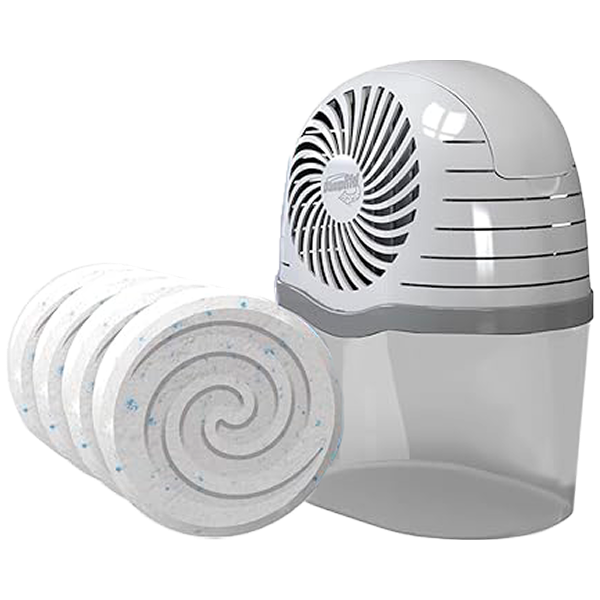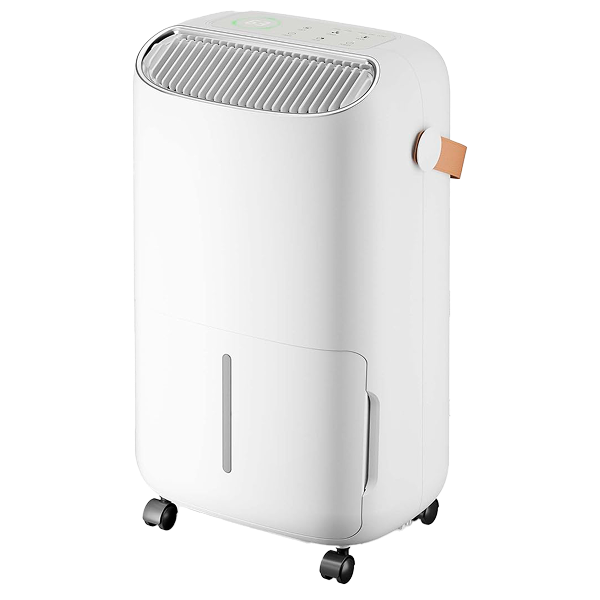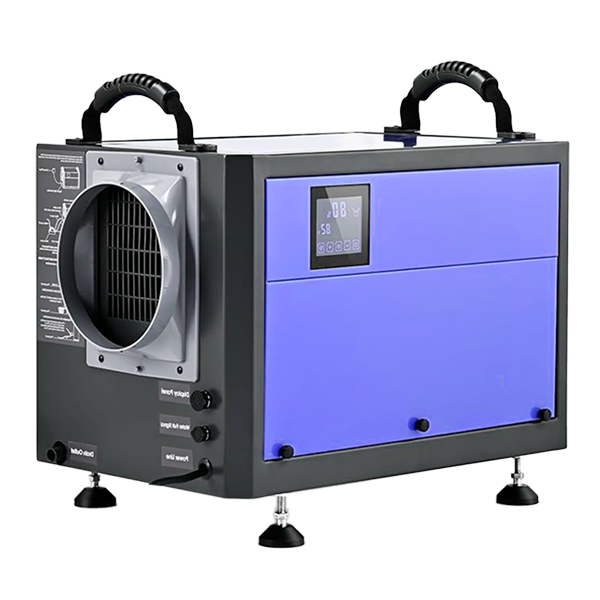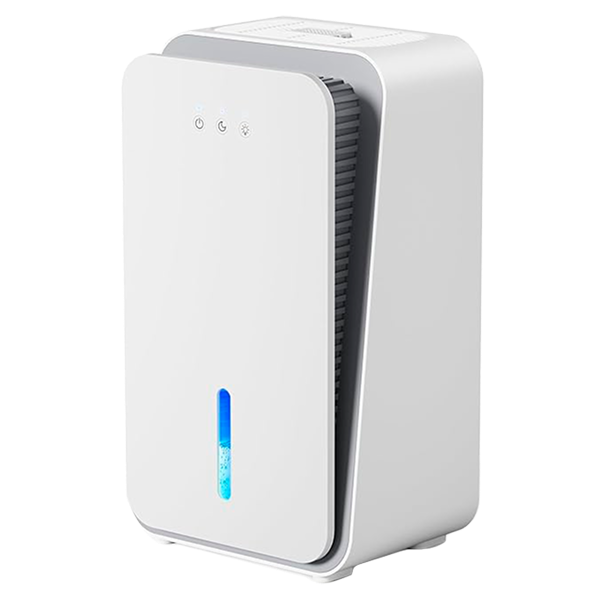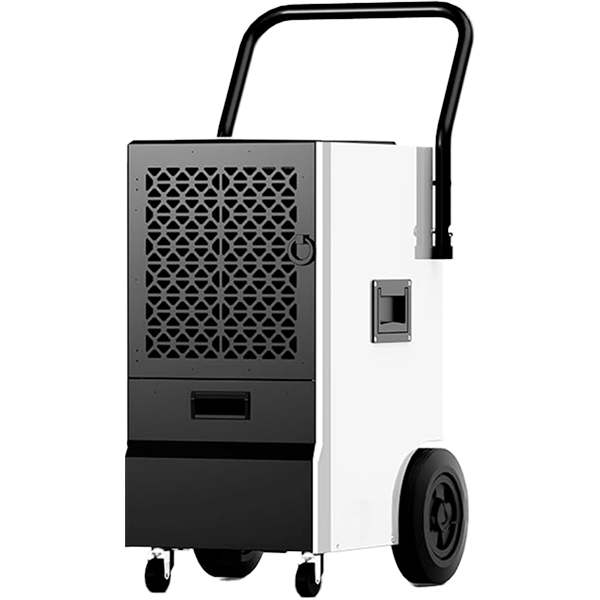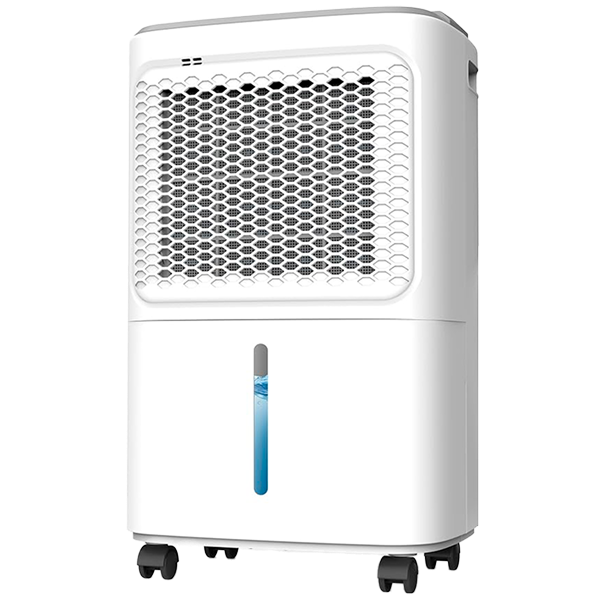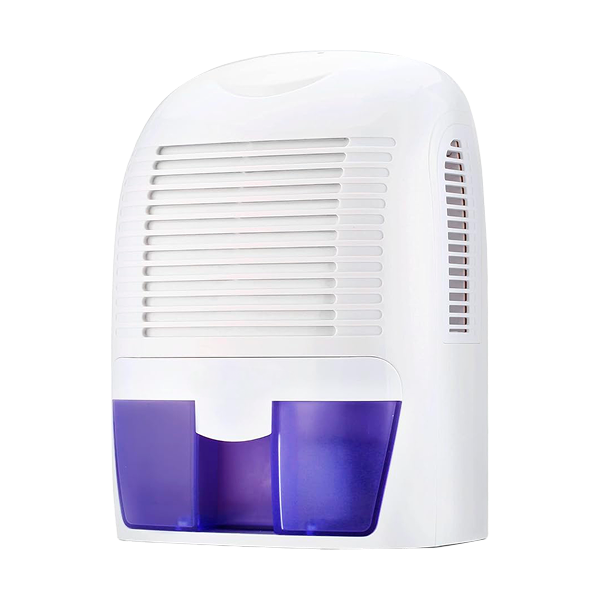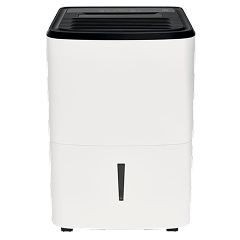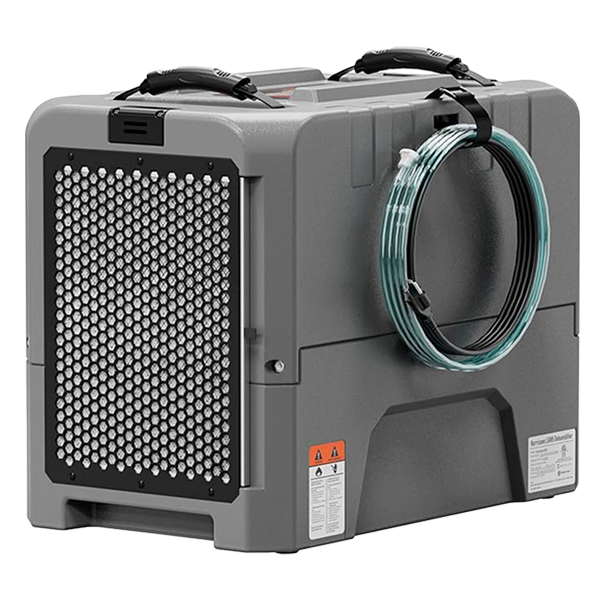Qu’il s’agisse de lutter contre la condensation sur les fenêtres de la salle de bain, d’empêcher la formation de moisissures dans les armoires ou de réguler le taux d’humidité dans une chambre à coucher, les petits déshumidificateurs sont le choix idéal pour les espaces restreints.
Bien qu’ils ne soient pas très imposants, de nombreux modèles vous surprendront par leurs puissance et sont souvent disponibles en plusieurs couleurs et designs pour s’harmoniser avec votre intérieur. Dans ce guide, nous vous expliquons ce qu’il faut rechercher afin que vous puissiez choisir un déshumidificateur adapté à votre espace et à vos besoins.
Pour un aperçu plus complet des différents types de déshumidificateurs, des scénarios courants dans les maisons et des principales marques, consultez notre guide d’achat général sur les déshumidificateurs.
Capacité d’extraction de l’humidité (L/24h)
Cela indique la quantité d’humidité que votre déshumidificateur peut éliminer de l’air en 24 heures. Pour les petites pièces, vous n’aurez pas besoin d’une capacité énorme, mais il est tout de même important de choisir la bonne capacité.
- 250 à 500 ml/jour – Capacité d’extraction standard commune à la plupart des petits modèles. Idéal pour les armoires, les placards ou les salles de bains attenantes.
- 0,5 à 1,5 l/jour – Un bon compromis. Idéal pour les chambres à coucher, les bureaux à domicile et les buanderies jusqu’à 20 m².
- 2 à 5 l/jour – Le choix idéal. Convient aux pièces de taille moyenne, telles que les salons ou les petits bureaux, ou aux espaces présentant des problèmes d’humidité persistants.
Plus l’humidité et la température ambiante sont élevées, plus le déshumidificateur sera efficace.
Capacité du réservoir
Le réservoir stocke l’humidité qui a été extraite de l’air. Pour les petits espaces, les réservoirs compacts sont courants, mais ils doivent être vidés plus régulièrement, ce qui peut devenir fastidieux à la longue, en particulier dans les pièces où l’humidité est un problème récurrent.
- <1 L – Vous devrez probablement le vider tous les jours. Convient à une utilisation occasionnelle ou aux petits espaces.
- 1 à 2 L – Courant dans la plupart des déshumidificateurs compacts. Équilibre entre petite taille et commodité.
- 2 à 3 L – Réduit la fréquence à laquelle vous devez le vider ; pratique pour une utilisation nocturne ou dans les pièces très fréquentées.
Recherchez des modèles équipés d’un indicateur de niveau d’eau visible ou d’une alerte de réservoir plein afin d’optimiser l’utilisation de votre déshumidificateur.
Zone de couverture
La capacité de l’appareil vous indique la taille de la pièce qu’il peut traiter. Vérifiez toujours que la capacité du déshumidificateur correspond à la taille de votre espace afin d’éviter d’acheter un appareil qui ne sera pas assez puissant. Demandez-vous si votre espace est ouvert et si le déshumidificateur sera capable d’atteindre l’humidité dans les recoins et les coins inaccessibles.
- Jusqu’à 10 m² – Pensez aux armoires, placards, salles de bains attenantes et petites pièces.
- 10–20 m² –Idéal pour les chambres individuelles, les petits bureaux ou les cuisines.
- 20–30 m² – Convient aux studios, salons ou buanderies.
Les portes ouvertes et une mauvaise isolation peuvent réduire la performance, alors assurez-vous que les portes soient fermées dans la pièce que vous ciblez.
Fonctionnalités de transport
Le principal argument de vente des petits déshumidificateurs est leur taille. Ils sont suffisamment compacts pour être placés sur des étagères et des tables de chevet, faciles à déplacer d’une pièce à l’autre et à ranger dans des placards ou sous un lit lorsqu’ils ne sont pas utilisés.
Tenez compte de ces détails lorsque vous effectuez vos recherches :
- Poignée ou prise intégrée – Facilite le déplacement d’une pièce à l’autre.
- Forme compacte – Les modèles fins trouvent parfaitement leur place sur des étagères ou sous les bureaux. Réfléchissez à l’endroit où vous souhaitez utiliser et placer votre déshumidificateur afin de déterminer la forme et la taille qui vous conviennent le mieux.
- Construction légère – Idéal pour le transport d’un étage à l’autre ou le rangement lorsqu’il n’est pas utilisé.
- Range-câble – Permet un rangement ordonné des câbles.
Niveau de bruit
Personne ne veut d’un appareil bruyant dans sa chambre à coucher. Cependant, il est important de garder à l’esprit que tous les déshumidificateurs font du bruit. Même si la règle « plus l’appareil est petit, moins il est bruyant » s’applique, il existe tout de même différentes options sur le marché. Choisissez en fonction de l’utilisation que vous souhaitez en faire :
- <35 dB – Pratiquement silencieux. Idéal pour les chambres à coucher et les chambres de bébé.
- 35–45 dB – Aussi doux que le murmure de la pluie – parfait pour une utilisation pendant la journée dans les salons ou les cuisines.
- 45–50+ dB – Perceptible mais pas gênant. Convient parfaitement aux buanderies, aux sous-sols et aux espaces laissés sans surveillance pendant l’utilisation.
Type de filtre et accès
Les filtres protègent les composants internes et peuvent purifier l’air. La plupart des modèles compacts sont équipés de filtres simples qui retiennent la poussière et améliorent la fraîcheur de l’air :
- Filtres à poussière lavables – Faciles à rincer et réutilisables.
- Filtres antibactériens – Idéaux pour les foyers sujets aux allergies
- Accès sans outil – Facilite le nettoyage.
Les filtres doivent être nettoyés ou remplacés régulièrement, en particulier dans les environnements poussiéreux. Calculez les coûts liés au remplacement et au nettoyage des filtres.
Les différents types de petits déshumidificateurs
Tous les petits déshumidificateurs ne fonctionnent pas de la même manière. La technologie qu’ils renferment influe sur leur efficacité dans différentes conditions, notamment en ce qui concerne la température ambiante et la consommation d’énergie. Voici un bref aperçu des trois principaux types de machines :
1. Déshumidificateurs Peltier (thermoélectriques)
Idéal pour : une utilisation quotidienne dans des pièces petites et chaudes
Ce sont les types de petits déshumidificateurs les plus courants. Ils utilisent le refroidissement thermoélectrique (technologie Peltier) pour extraire l’humidité sans compresseur, ce qui les rend légers, silencieux et économes en énergie.
- Taille typique : extraction de 250 ml à 1,5 L/jour
- Avantages : fonctionnement silencieux, faible consommation d’énergie, compact et abordable
- Inconvénients : moins puissant ; ne convient pas aux pièces froides ou aux grandes surfaces
- Idéal pour : chambres à coucher, salles de bains, armoires, chambres d’étudiants
2. Déshumidificateurs à réfrigérant (à compresseur)
Idéal pour : les espaces plus humides ou les températures plus fraîches mais supérieures à 15 °C
Ces appareils aspirent l’air à travers un serpentin froid, ce qui provoque la condensation de l’humidité qui s’accumule dans un réservoir. Ils sont généralement plus puissants que les modèles Peltier, même dans des formats compacts, mais ont tendance à être un peu plus lourds et plus bruyants.
- Capacité typique : extraction de 1,5 à 5 litres par jour
- Avantages : forte capacité d’élimination de l’humidité, fonctionne bien dans les pièces chaudes
- Inconvénients : légèrement plus bruyant, plus encombrant, moins efficace en dessous de 10 à 15 °C
- Idéal pour : salons, cuisines, buanderies, grandes chambres
3. Déshumidificateurs à dessiccant
Idéal pour : les espaces froids et des performances constantes tout au long de l’année
Les modèles à dessiccant utilisent un matériau absorbant l’humidité (comme le gel de silice) pour extraire l’eau de l’air, qui est ensuite chauffée et expulsée. Ils fonctionnent très bien dans les environnements plus froids où d’autres types de modèles peuvent rencontrer des difficultés.
- Capacité typique : 2 à 7 litres par jour
- Avantages : fonctionne bien dans les pièces froides, séchage constant, souvent plus silencieux que les modèles à compresseur
- Inconvénients : consomme plus d’énergie, peuvent être plus coûteux
- Idéal pour : garages, vérandas, sous-sols non chauffés, buanderies froides
Plage de température de fonctionnement
La plupart des petits déshumidificateurs fonctionnent mieux dans des conditions chaudes et humides :
- Standard: 15–35°C
- Pièces fraîches : pour les pièces plus fraîches, dont la température est inférieure à 15 °C, choisissez des modèles avec fonction de dégivrage automatique ou optez pour des modèles plus grands à dessiccant (garages et sous-sols froids).
Contrôle de l’humidité
Cette fonctionnalité intelligente et indispensable vous permet de définir un niveau d’humidité cible. Le déshumidificateur fonctionnera jusqu’à ce qu’il atteigne ce niveau, puis s’éteindra automatiquement :
- Cadran manuel – Simple et facile à utiliser.
- Affichage numérique – Plus précis et facilement réglable.
Arrêt automatique (réservoir plein)
Il s’agit d’une fonctionnalité indispensable dans les petits déshumidificateurs. Elle arrête l’appareil lorsque le réservoir est plein afin d’éviter les fuites et est souvent associée à un indicateur de réservoir plein, généralement un voyant LED lumineux ou un réservoir d’eau éclairé. Ainsi, vous êtes toujours averti lorsque vous devez vider le réservoir d’eau et pouvez optimiser l’utilisation du déshumidificateur.
Fonctionnalités supplémentaires
Connectivité intelligente/application + fonctionnalités de l’application
Bien que cela ne soit pas très courant pour les petits déshumidificateurs, certains modèles compacts intègrent désormais une connectivité Wi-Fi ou Bluetooth. Les fonctionnalités que vous pourrez utiliser via votre téléphone dépendent du modèle et du fabricant. Elles comprennent généralement :
- Contrôle à distance – Réglez les paramètres depuis votre téléphone.
- Alertes d’humidité – Recevez une notification en cas d’augmentation soudaine du taux d’humidité.
Options de couleurs et designs
De nombreux petits déshumidificateurs sont conçus pour s’intégrer dans les espaces de vie modernes. Ils sont souvent disponibles dans des tons neutres comme le blanc, le gris ou des pastels doux qui s’harmonisent facilement avec la plupart des intérieurs. Ces choix de couleurs subtiles les rendent idéaux pour les chambres, les salles de bains et les bureaux à domicile où vous recherchez la fonctionnalité sans encombrement visuel.
Certains modèles vont encore plus loin avec des designs élégants et minimalistes, caractérisés par des bords lisses, des finitions brillantes ou des formes compactes qui s’intègrent parfaitement sur les étagères ou les plans de travail. Si l’esthétique est importante pour vous, il vaut la peine de rechercher des modèles qui complètent votre style, qu’il s’agisse du minimalisme scandinave ou d’un style plus excentrique pour une chambre d’enfant.
Déshumidificateur ou absorbeur d’humidité ?
Le marché regorge de petits déshumidificateurs à des prix compétitifs, principalement parce qu’ils sont moins chers à produire que les grands compresseurs. Leur taille compacte réduit également les frais de livraison, car ils peuvent être expédiés en plus grand nombre.
Contrairement aux déshumidificateurs, qui utilisent l’électricité pour extraire l’humidité et peuvent fonctionner en continu, les absorbeurs d’humidité sont passifs : ils utilisent des cristaux, des pastilles ou du gel pour absorber lentement l’humidité. Ils sont généralement jetables, ce qui les rend moins durables et potentiellement plus coûteux à long terme. Les absorbeurs d’humidité fonctionnent mieux dans des espaces très petits et fermés, comme les tiroirs, sous les éviers ou à l’intérieur des placards, et ne conviennent pas à une utilisation continue dans une pièce.
Aperçu des principaux fabricants
Pro Breeze
Idéal pour : une utilisation quotidienne abordable | Fabrication adaptée au climat du Royaume-Uni
Pro Breeze est l’une des marques les plus populaires dans le domaine des déshumidificateurs compacts. Leurs modèles sont conçus pour les foyers britanniques et offrent des fonctionnalités fiables dans un format convivial.
- Capacité d’extraction généralement comprise entre 500 ml et 2 l/jour
- Conception légère et facile à utiliser
- Excellent pour les salles de bains, les chambres et les caravanes
- Prix abordable sans sacrifier les fonctionnalités essentielles
Inconvénients : ne propose que des fonctionnalités de base et une coque en plastique, sans fonctions intelligentes ni filtration supplémentaire.
Meaco
Idéal pour : une technologie intelligente et silencieuse | Utilisation dans une chambre à coucher
Meaco est spécialisé dans les appareils silencieux et efficaces qui s’intègrent parfaitement dans les maisons modernes. Leur gamme « ABC » est particulièrement appréciée dans les espaces sensibles au bruit.
- Presque silencieux (seulement 35 dB)
- Affichage numérique avec humidité cible
- Faible consommation d’énergie avec modes minuterie
- Certains modèles offrent un drainage continu
Inconvénients : prix plus élevé, mais vous bénéficiez de fonctionnalités sophistiquées et d’une assistance.
Airthereal
Idéal pour : Ses modèles compacts, élégants et performants
Les déshumidificateurs Airthereal allient un design attrayant à des performances impressionnantes, et sont souvent équipés d’une connectivité via application et de plusieurs vitesses de ventilation.
- Boîtier élégant avec affichage LED de l’humidité
- De nombreux modèles sont équipés d’une commande via application
- Disponible dans des tons pastel ou blanc minimaliste
- Modes Eco et minuteries intégrés
Inconvénients : légèrement plus encombrants que les modèles basiques ; la disponibilité peut varier.
Silentnight
Idéal pour : une déshumidification simple et sans tracas | Petits budgets
Cette marque réputée apporte sa réputation de sommeil paisible au contrôle de l’humidité. Les modèles Silentnight sont simples, compacts et faciles à utiliser.
- Appareils ultra-compacts de 500 ml à 1 litre
- Idéaux pour les très petites pièces
- Branchez-les et utilisez-les immédiatement, sans configuration particulière
- Parfaits pour les nouveaux utilisateurs ou les logements étudiants
Inconvénients : Pas de fonctionnalités avancées ni d’option de drainage, mais vous en avez pour votre argent.


